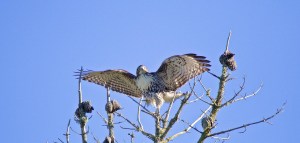Jennifer Berry’s final report on the ecosystem of the Saucelito Creek Wildlife Refuge is now available. It contains recommendations to benefit its existing riparian species and to attract new ones. Jennifer Berry is a field biologist who lives in the area and has been studying the species that utilize the area around the Saucelito Creek Wildlife Refuge for several years.
See our Wildlife Photos and Videos page for videos and photos taken by Jennifer Berry’s motion-activated cameras capturing gray fox, coyote, deer, quail and other wildlife in Sausalito.

The above map shows 50 contiguous acres of wildlife habitat within northern Sausalito surrounded by yellow and green lines. The region includes the Saucelito Creek Wildlife Refuge at the far left (Lincoln/Butte Parcel on the map), the site of the only creek and only water source within the entire area. You can help maintain and improve the creek and the wildlife refuge by making a tax-deductible donation.
Here are some highlights from Berry’s earlier report on why it was important to preserve the Lincoln-Butte Parcel (now the Saucelito Creek Wildlife Refuge) as an undeveloped wildlife habitat:
- The site has been listed by the U.S. Fish & Wildlife Service as a wetlands resource. It is only one of two such sources for water in Sausalito, as the remaining seasonal creeks, springs and natural water sources that Sausalito is famous for have been diverted underground into culverts that either drain to the Bay or feed into the city stormwater system.
- The wildlife refuge is the northernmost edge of a tract of undeveloped land stretching more than 50 acres in size from Butte Street in the north to south of Rodeo Ave and includes Cypress Ridge Open Space. While the wildlife refuge may only comprise the northern corner and only 2.1 acres of this entire Open Space, camera traps have determined that it is crucial for its wildlife that the parcel remain undeveloped. The spring-fed creek is being accessed daily by wildlife in the area, including black-tailed deer, coyotes, bobcats, foxes, dusky-footed woodrat, bats and many other species. These animals travel between Cypress Ridge via the chain of trails, behind residences on a wild hillside just below 101, to the source of the spring on the wildlife refuge.
- Species that have suffered dramatic decline in recent years are Pacific salamander and Pacific newt, both of which are present on the site. Many other special status species could be determined to live here, including the valley longhorned elderberry beetle, several bats, warblers and flycatchers, red-legged frog, and yellow-frog, to name a few likely to be found here.
- While it might seem unlikely that species of concern could find refuge within a parcel surrounded by urban development, there are several indicators that this could in fact be the case. Coyotes, a keystone predator in urban forests and an indicator of health in such an ecosystem, keep in balance many species of smaller predators such as raccoons, feral cats and skunks who would otherwise prey on nesting birds. Indeed this site supports some 20 or more nesting birds, including birds of prey. Coyotes also help maintain forest health by keeping in check populations of herbivores including deer, rodents and rabbits who would otherwise overgraze and deplete the forest of its vegetation.
- The final point to be made for this tract of land is that the wildlife here are in all likelihood landlocked, with the 101 freeway making a hard western boundary they do not cross. The only safe corridor to Sausalito is the land bridge above the Robin Williams Tunnel. Radio collared survery have determined that bobcats and foxes use this land bridge to cross into Sausalito (Riley). These same surveys came to the same conclusion that indeed the 101 corridor is a barrier to wildlife in all locations both north and south of the wildlife refuge.
- The 101 freeway from the Golden Gate Bridge to Marin City has been assessed on foot by Berry over the last five years to determine any potential culverts designed for water flow but suitable for wildlife to use to cross under the freeway. There are no such culverts, though the potential exists.
- In summary these wild animals spend their whole lives here in the city limits as our neighbors, and do not access the open space of GGNRA.
In conclusion to the findings to date, it is of the opinion of Jennifer Berry that the Lincoln-Butte parcel (now the Saucelito Creek Wildlife Refuge) would best be left undeveloped for the sake of wildlife, including potential species of concern.

Jennifer Berry

